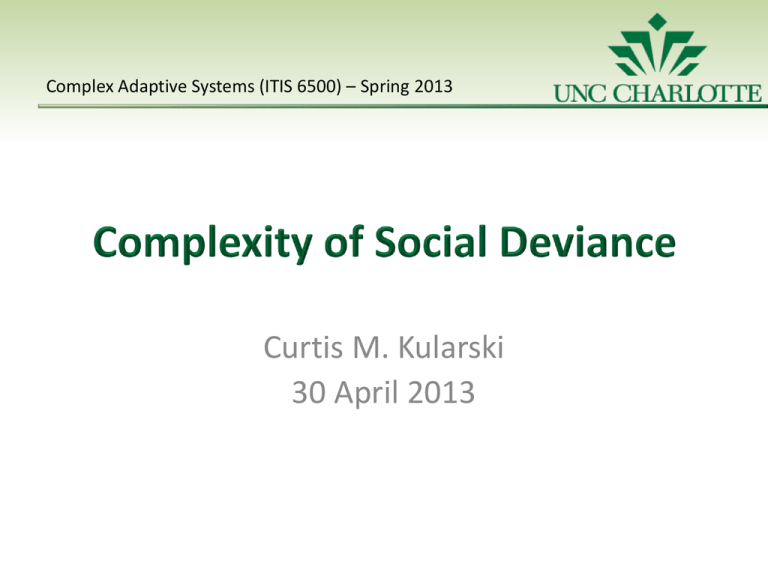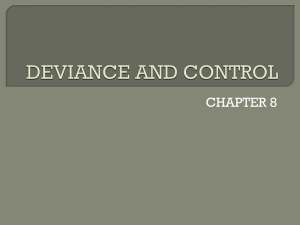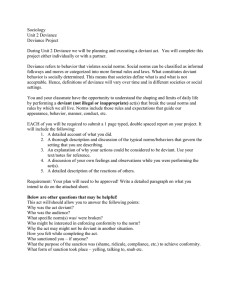Complexity of Social Deviance
advertisement

Complex Adaptive Systems (ITIS 6500) – Spring 2013 Curtis M. Kularski 30 April 2013 Walter Buckley – first sociologist to conceive of society as a CAS in 1968 Society does not seek equilibrium Cannot be predicted using a linear model Social systems are dependent on: Relationships between elements (agents) Information Environmental schemata (physical and “network”) Behavior is not easily predictable Each agents implements the “rules” differently Various groupings in the system behave differently Requires development of scales for decision making separate from complexity measures Testing is limited to subsets of society Determine the variables that have the largest impact on deviance and model social interactions based on the assumptions of those variables Understand the relationship between social controls and free will (agency) Predict outcomes for a particular deviance in a given population For modeling social systems, existing theoretical approaches to understanding social behavior can be applied CAS/ABM can function as a different way to test existing theories Structural aspects of society often prevail, despite cases of deviance or anomie Combination of formal and informal structures Agents in social systems are all people of a particular society Can be grouped to smaller sub-systems based on identification Agents in social system exercise free will in relation to (or in anomie with) the controls of their social context Folkways/Customs – Traditions of the culture Mores – Informal rules of conduct in a society Rules – Formal procedures for institution or subset of system Laws – Formal rules for society Number of close relationships (control theory) Previous occurrence of deviance (labeling theory) Congruence between identity and self-concept (labeling theory) Severity of sanctions, relative to weight of deviation Behavior of close agents (differential association) Using the “wrong” spoon at a formal dinner Exceeding posted speed limits Plagiarizing an exam Theft Homicide Rules are different in each situation/context Agents weigh potential behaviors in context Context is often defined by nearby agents Nudity: Western culture rules of modesty In private, while bathing: no sanctions, acceptable In private, with friends: dependent upon “friendly” agents In public: violation of mores and laws Agent must consider environment and relationship with other agents before enacting a behavior The default state of a social system is compliance (social identity theory) Social agents deviate when compliance is against personal goals Agents in society use many factors in deciding in a deviation In attempt to return to default state, deviant agents will attempt to form social connections to similarly deviant agents New social connections affirm a new social identity In the absence of self-organization, deviant agents are re-absorbed by larger system “rehabilitation” to norms is encouraged Rebellious agents are outliers that also tend to self-organize Social information includes: Nearby agents Knowledge of rules/norms and sanctions Perceived likelihood of enforcement of norms Internalized identity Goals associated with identity (risk/benefit to goals as a result of deviance) Rational Choice Theory indicates this is the primary basis for deviance or conformity Complexity for social systems can be measured in various ways: Number of agents/nodes affected Number of factors to be considered before a decision Levels of hierarchical depth influencing decisions/interactions Fitness of CAS model of deviance would need to be tested against normal societal measures of deviance (number of occurrences per 1000) of a particular behavior Model would likely only be able to test for one type of deviance at a particular time No agent-specific predictions are expected, only system-level predictions of occurrence A CAS designed to model social behavior can only be validated against a particular social and temporal context for which the system was designed Outcome of system may vary based on factors that affect the individual agents if the model is not sufficiently complex CAS may be an effective way of predicting factors that influence deviance for a large social system A variety of variables act on agents to influence how they implement rules Connections to other agents are an important factor in social decision-making Presentation is an adaptation of a paper of the same title submitted for ITIS 6500 on 30 April 2013. For references, please see original paper Presentation theme is an adaptation of a theme created by Dr. Stephanie Moller, Department of Sociology, UNC Charlotte Author is a dual Masters degree student in Sociology and Information Technology at UNC Charlotte



